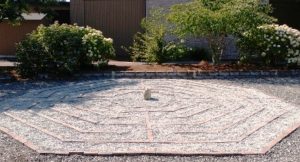A Path with a Purpose
 • In Summer 2017, Calvin Church received a wonderful new addition to our campus–a prayer labyrinth built as an Eagle Scout project by Micah Trainer and fellow Boy Scouts from Troop 348. The labyrinth is located at the northeast corner of our facility near the playground.
• In Summer 2017, Calvin Church received a wonderful new addition to our campus–a prayer labyrinth built as an Eagle Scout project by Micah Trainer and fellow Boy Scouts from Troop 348. The labyrinth is located at the northeast corner of our facility near the playground.
What is a Prayer Labyrinth?
A prayer labyrinth is a path with a purpose. It is not a maze with tricks and dead-ends, but a pattern with a single route to the center. The prayer labyrinth is not meant to disorient you, but to reorient you. For centuries, Christians have walked labyrinths as a way to engage the body as well as the heart and spirit in contemplation and meditation. In the Middle Ages, people used labyrinths as a simple and symbolic way to enact a pilgrimage without the time and expense normally required. One of the most famous labyrinths is found in the Chartres Cathedral in France, dating back to the 1200s.
Calvin Church’s Prayer Labyrinth
 Calvin Church’s labyrinth is a six-circuit design called an Abingdon Octagonal. The pattern is adapted from a medieval manuscript labyrinth, and it was made with a simple border of Old Country Stone and a gravel path. The labyrinth is open to all to use. The church simply asks for everyone’s cooperation in keeping the area clean and accessible.
Calvin Church’s labyrinth is a six-circuit design called an Abingdon Octagonal. The pattern is adapted from a medieval manuscript labyrinth, and it was made with a simple border of Old Country Stone and a gravel path. The labyrinth is open to all to use. The church simply asks for everyone’s cooperation in keeping the area clean and accessible.
Guidelines for Using the Labyrinth
There is no “required” way to walk a labyrinth. However, the Calvin Prayer Labyrinth is intended for Christian use. Its purpose is to draw us closer to the God revealed in Jesus Christ, who is the center of our lives and the Rock of our salvation. Because of its simplicity, both adults and children may find the prayer walk meaningful. Because of its design, each step brings you closer to the goal even if the circuitous course seems to be leading you away.
 If others are present, avoid all unnecessary conversation so those walking the labyrinth may concentrate and pray. Before entering, take time to be still and quiet. Center your heart and mind on the real presence of God with you and within you.
If others are present, avoid all unnecessary conversation so those walking the labyrinth may concentrate and pray. Before entering, take time to be still and quiet. Center your heart and mind on the real presence of God with you and within you.
When you enter, walk at a pace that feels natural. Do not rush. Since the path is two-way, you may catch a person in front of you or meet someone coming the other way; simply pass by him or her and return to the path. Take whatever time you need in the center.
Ways to Walk the Prayer Labyrinth
A common approach to walking a labyrinth has three stages. The first stage is Releasing. As you move toward the center of the labyrinth, focus on letting go of worldly attachments, shedding distractions, and coming to God as your true self. The second stage is Receiving. At the center, seek to come to the center of your relationship with God. Stay as long as you like, spending time reflecting on your relationship with God and receiving what God would give you. The third stage is Returning. As you follow the same path out, be conscious of God walking with you back into your day.
Other approaches to a labyrinth walk and prayer include:
- Confession. On the way to the center, acknowledge your sin and ask for forgiveness and cleansing. At each of the turns, imagine doing a U-turn of repentance, a turning back to God. At the center, imagine leaving your sin there with Christ. Receive and rejoice in God’s forgiving grace on the way back. Pause at the exit and give thanks for your cleansing journey.
- Meditation. Meditate on a specific word or short phrase of Scripture. Or, recite a breathe prayer—a short phrase that is repeated at each leg or each turn (e.g., “Lord, have mercy;” “be still my soul;” or “the Lord is my shepherd, I shall not want”). You may use a different word or prayer on the way out.
- Conversation. Have a conversation with God. Perhaps use one direction for speaking, and the other direction for listening. Pause at the turns as needed.
- Intercession. Offer prayers for specific people, for the church, for our community, and for the world.
- Discernment. Ask God a question as you enter the path. Then, as you walk slowly through the twists and turns, listen for an answer. Let your steps and your silence invite the guidance of God.
- Unburdening. Lay down your burdens as you walk to the center of the labyrinth (perhaps carry and place a rock in the center as a symbol of your worries or cares). Pause to thank God for taking your burdens on himself. Then count your blessings and give thanks on the journey to the exit.
